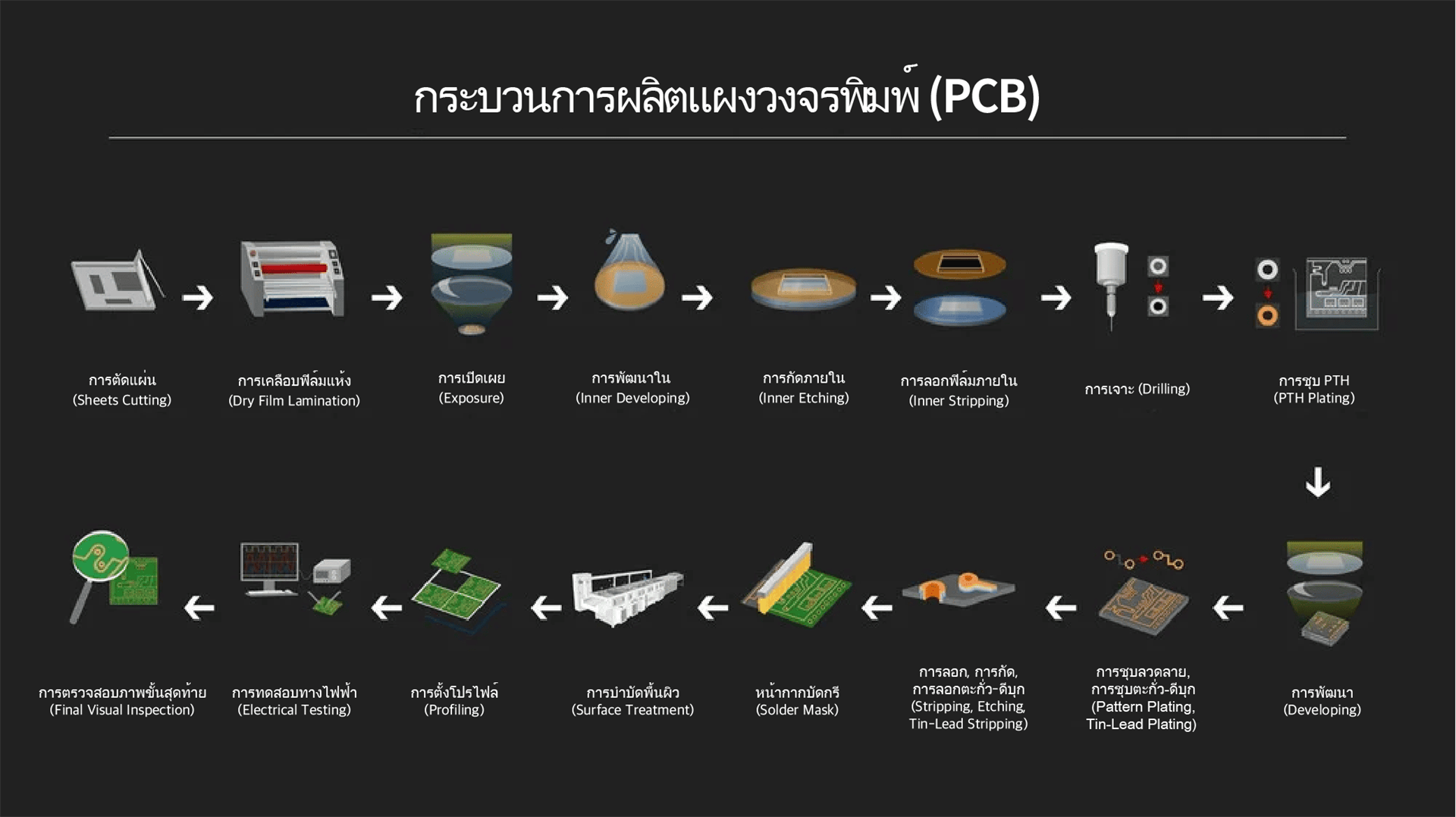การผสมผสานเทคโนโลยีปัญญาประดิษฐ์ (AI) ในการออกแบบแผงวงจรพิมพ์ (PCB) ถือเป็นก้าวสำคัญที่ช่วยเพิ่มประสิทธิภาพและการปรับแต่งในวิศวกรรมระบบอิเล็กทรอนิกส์ การผสานนี้ช่วยสร้างยุคใหม่ของการปรับแต่งการออกแบบและการทำงานอัตโนมัติ พร้อมเร่งรอบการพัฒนาผลิตภัณฑ์
ในกระบวนการออกแบบ PCB แบบดั้งเดิม งานต่างๆ เช่น การสร้างแผนภาพ, การวางส่วนประกอบ, การวางเส้นทางการเชื่อมต่อ, และการปรับแต่งเค้าโครงเพื่อความสมบูรณ์ของสัญญาณและความสามารถในการผลิต จะทำด้วยมือ ซึ่งต้องอาศัยความเข้าใจลึกซึ้งเกี่ยวกับอิเล็กทรอนิกส์และหลักการวิศวกรรม อย่างไรก็ตาม ความซับซ้อนที่เพิ่มขึ้นของอุปกรณ์อิเล็กทรอนิกส์และความต้องการประสิทธิภาพที่สูงขึ้นได้ผลักดันให้ต้องใช้แนวทางที่ชาญฉลาดกว่าในการออกแบบ PCB โดย AI, โดยเฉพาะในรูปแบบของเทคโนโลยีการเรียนรู้ของเครื่อง (machine learning) และการเรียนรู้เชิงลึก (deep learning) กำลังถูกผสานเข้ากับเครื่องมือ Electronic Design Automation (EDA) ซึ่งช่วยปฏิวัติการออกแบบ PCB ด้วยการวางส่วนประกอบอัตโนมัติ, การเพิ่มประสิทธิภาพการวางเส้นทาง, การตรวจสอบกฎการออกแบบ, และการปรับปรุงอื่นๆ ที่ขับเคลื่อนด้วย AI
การใช้ AI ในการออกแบบ PCB เปิดโอกาสใหม่สำหรับการปรับแต่งการออกแบบ แต่ก็มีความท้าทายและข้อพิจารณาทางจริยธรรมใหม่ๆ เช่น ข้อจำกัดในการออกแบบที่ซับซ้อน, การทำงานร่วมกันระหว่างสาขาวิชา, การปฏิบัติตามข้อกำหนดด้านกฎระเบียบ, และปัญหาความเป็นส่วนตัวและความปลอดภัยของข้อมูล ถึงแม้ว่าจะมีความท้าทายเหล่านี้ บทบาทของ AI ในการออกแบบ PCB คาดว่าจะเป็นส่วนสำคัญในการกำหนดอนาคตของการออกแบบอิเล็กทรอนิกส์
[4]
แผงวงจรพิมพ์ (PCB) ประกอบด้วยส่วนประกอบอิเล็กทรอนิกส์จำนวนมากและใช้วัสดุที่นำไฟฟ้า เช่น เส้นทางทองแดง เพื่อเชื่อมโยงส่วนประกอบต่างๆ ตามคุณสมบัติของผลิตภัณฑ์และการใช้งาน PCBs สามารถแบ่งออกเป็นประเภทต่างๆ ดังนี้:
1. Single-Layer PCB - แผงวงจรพิมพ์แบบชั้นเดียวมีชั้นการนำไฟฟ้าเพียงชั้นเดียวที่ด้านหนึ่งของแผง โดยด้านอื่นใช้ในการรวมวงจรอิเล็กทรอนิกส์ที่แตกต่างกัน พบทั่วไปในผลิตภัณฑ์อิเล็กทรอนิกส์ที่มีความซับซ้อนไม่มาก เช่น เครื่องคิดเลขและวิทยุ
2. Double-Layer PCB - ในแผงวงจรพิมพ์แบบสองชั้น มีชั้นการนำไฟฟ้าทั้งสองด้านของวัสดุรองพื้น ซึ่งแยกด้วยชั้นฉนวน ส่วนประกอบบนทั้งสองด้านจะเชื่อมต่อผ่านช่องทางที่มีการเคลือบ ซึ่งช่วยให้สามารถออกแบบวงจรที่กะทัดรัดขึ้น
3. Multi-Layer PCB - แผงวงจรพิมพ์หลายชั้นประกอบด้วยหลายชั้นของฟอยล์ทองแดงที่แยกด้วยวัสดุฉนวนทั้งหมดถูกบีบรวมกันภายใต้แรงดันและอุณหภูมิสูง เพื่อความทนทาน ช่วยให้การรวมวงจรสูงและการออกแบบที่ซับซ้อน ซึ่งเหมาะสำหรับผลิตภัณฑ์อิเล็กทรอนิกส์ขั้นสูง เช่น อุปกรณ์จัดเก็บข้อมูล, ระบบดาวเทียม, อุปกรณ์ทางการแพทย์, และอุปกรณ์ GPS
4. Rigid PCB - หรือที่เรียกว่าแผงวงจรพิมพ์แข็ง ใช้เรซินอีพ็อกซี่เสริมไฟเบอร์กลาส (FR-4) เป็นวัสดุพื้นฐาน แผงวงจรพิมพ์แข็งมีความทนทานและไม่ยืดหยุ่น ซึ่งใช้ในหน่วยประมวลผลกลาง (CPU) ของเมนบอร์ดคอมพิวเตอร์, อุปกรณ์ตรวจสอบทางการแพทย์, และอุปกรณ์อัตโนมัติในอุตสาหกรรม
5. Rigid-Flex PCB – หรือที่เรียกว่าแผงวงจรพิมพ์แบบยืดหยุ่นและแข็ง ประกอบด้วยพื้นที่แข็งและยืดหยุ่นที่เชื่อมต่อกันผ่าน Flex Connectors การจัดตำแหน่งที่แม่นยำและการฉาบผิวเป็นสิ่งสำคัญในการเชื่อมต่อ โดยใช้ Plated Through Holes (PTH) เพื่อสร้างการเชื่อมต่อหลายชั้น
6. Flexible PCB – หรือที่เรียกว่า Flex PCB ผลิตจากวัสดุที่ยืดหยุ่น เช่น ฟิล์มโพลีเอสเตอร์หรือโพลีอิมีด มีความสามารถในการงอและมีน้ำหนักเบา มีค่าใช้จ่ายในการผลิตสูง เหมาะสำหรับแอปพลิเคชันที่ต้องการความยืดหยุ่นและพื้นที่จำกัด เช่น จอแสดงผล, นาฬิกาอัจฉริยะ, แผงเครื่องมือในอวกาศ, และระบบบันเทิง
7. High-Frequency PCB – ออกแบบสำหรับสัญญาณความถี่สูงและแอปพลิเคชันไมโครเวฟ ต้องการการควบคุมอิมพีแดนซ์เพื่อหลีกเลี่ยงการสะท้อนของสัญญาณจากการรบกวนทางแม่เหล็กไฟฟ้า (EMI) และการรบกวนความถี่วิทยุ (RFI) มักใช้ในอุปกรณ์การสื่อสารแบบไร้สายและระบบเรดาร์
8. HDI PCB (High-Density Interconnect PCB)** – ใช้ Microvias, Blind Vias, และ Buried Vias ร่วมกับการบรรจุ BGA เพื่อให้การรวมและการเชื่อมต่อมีความหนาแน่นสูง ใช้ในอุปกรณ์อิเล็กทรอนิกส์ที่มีประสิทธิภาพสูง เช่น สมาร์ทโฟน, แท็บเล็ต, และอุปกรณ์การสื่อสารที่ซับซ้อน
9. Metal Core PCB – ใช้โลหะเป็นวัสดุพื้นฐานแทนไฟเบอร์กลาสแบบดั้งเดิม ฟอยล์ทองแดงใน Metal Core PCB ช่วยให้การระบายความร้อนดีกว่า ใช้ในแอปพลิเคชันที่มีความร้อนสูง เช่น การส่องสว่าง LED และตัวแปลงพลังงานแสงอาทิตย์
[5][6][7]

ขั้นตอนที่ 1: การตัดแผ่น (Sheets Cutting)
ตัดวัสดุรองพื้น (substrate) ให้มีขนาดตามที่ต้องการ
ขั้นตอนที่ 2: การเคลือบฟิล์มแห้ง (Dry Film Lamination)
เคลือบพื้นผิวของแผ่นวงจรด้วยฟิล์มออร์แกนิกที่ไวแสง หลังจากการเปิดเผยแสงแล้ว จะถ่ายโอนลวดลายวงจรจากฟิล์มไปยังแผ่นวงจร
ขั้นตอนที่ 3: การเปิดเผย (Exposure)
นำแผ่นวงจรที่ติดฟิล์มแห้งไปใส่ในเครื่องเปิดเผยแสงสำหรับการเปิดเผย ฟิล์มแห้งจะเกิดการแข็งตัวจากแสงไวแสงหลังจากถูกแสงยูวีในพื้นที่ที่โปร่งใสของฟิล์ม การเปิดเผยนี้จะถ่ายโอนภาพวงจรจากฟิล์มไปยังพื้นผิวของแผ่นวงจร
ขั้นตอนที่ 4: การพัฒนาใน (Inner Developing)
ละลายฟิล์มแห้งที่ไม่ไวแสงในสารละลายพัฒนาเพื่อสร้างลวดลายวงจรชั้นใน
ขั้นตอนที่ 5: การกัดภายใน (Inner Etching)
หลังจากฟิล์มแห้งที่ยังไม่ได้พัฒนาละลายไปแล้ว พื้นผิวทองแดงที่อยู่ด้านล่างจะถูกเปิดเผย จากนั้นแผ่นวงจรจะผ่านกระบวนการกัด ซึ่งในขั้นตอนนี้ พื้นผิวทองแดงที่ถูกเปิดเผยจะถูกละลายด้วยสารละลายกัดเพื่อเปิดเผยวัสดุรองพื้นด้านล่าง พื้นผิวทองแดงที่ยังติดฟิล์มแห้งจะยังคงอยู่โดยสมบูรณ์ และจะเป็นการสร้างวงจรภายในแผ่นวงจรพิมพ์
ขั้นตอนที่ 6: การลอกฟิล์มภายใน (Inner Stripping)
ใช้สารละลายลอกฟิล์มเพื่อลบฟิล์มแห้งที่แข็งตัวจากกระบวนการเปิดเผยแสงออกจากแผ่นวงจร
ขั้นตอนที่ 7: การเจาะ (Drilling)
ในกระบวนการเจาะ PCB จะมีการเจาะรูหลายประเภท เช่น รู vias (เช่น thru-holes, buried holes, blind holes, และ micro-holes) รวมถึงรูสำหรับส่วนประกอบและรูทางกล เนื่องจากต้องการความแม่นยำ รูเหล่านี้จะถูกผลิตโดยการใช้เครื่องเจาะมือหรือเครื่องเจาะ PCB ด้วยเลเซอร์ โดยเราผลิตส่วนประกอบต่างๆ เช่น รูตามความต้องการของลูกค้า, รูสำหรับติดตั้ง, รูผ่าน, และรูสำหรับการจัดตำแหน่งที่จำเป็นสำหรับการทำกระบวนการหลังการผลิต นอกจากนี้ยังมีการจัดหาช่องตรวจสอบเมื่อจำเป็นต้องมีการควบคุมคุณภาพ
ขั้นตอนที่ 8: การชุบ PTH (PTH Plating)
กระบวนการชุบไฟฟ้าผ่านรู (PTH) หรือที่เรียกว่าการชุบทองแดงแบบครั้งเดียว คือการเคลือบทองแดงบางๆ บนผนังรูที่ทำจากเรซินที่ไม่สามารถนำไฟฟ้าหรือไฟเบอร์กลาส กระบวนการนี้มีจุดประสงค์เพื่อทำให้ผนังรูเป็นโลหะ และช่วยให้การเชื่อมต่อระหว่างชั้นวงจรภายในและภายนอกสามารถทำได้
ขั้นตอนที่ 9: การพัฒนา (Developing)
ละลายฟิล์มแห้งที่ยังไม่ได้เปิดเผยบนชั้นภายนอกของแผ่นวงจร
ขั้นตอนที่ 10: การชุบลวดลาย, การชุบตะกั่ว-ดีบุก (Pattern Plating, Tin-Lead Plating)
หลังจากการพัฒนา ขั้นตอนถัดไปคือการชุบทองแดงสองชั้นและการชุบตะกั่ว-ดีบุก ซึ่งมีจุดประสงค์เพื่อเพิ่มความหนาของชั้นภายนอกของวงจร การชุบดีบุกมีจุดประสงค์เพื่อปกป้องทองแดงที่อยู่ใต้ชั้นดีบุกจากการละลายในสารละลายกัดในกระบวนการถัดไป
ขั้นตอนที่ 11: การลอก, การกัด, การลอกตะกั่ว-ดีบุก (Stripping, Etching, Tin-Lead Stripping)
โดยใช้สารละลายลอกฟิล์ม ฟิล์มแห้งบนพื้นผิวของแผ่นวงจรถูกลบออก เปิดเผยชั้นทองแดงที่อยู่ด้านล่าง หลังจากการกัดด้วยสารละลายกัด ชั้นทองแดงที่ถูกเปิดเผยจะถูกละลายออกไปและเปิดเผยวัสดุรองพื้น พื้นผิวทองแดงที่ชุบด้วยดีบุกจะไม่ถูกกระทบกระเทือนเนื่องจากชั้นป้องกันของดีบุก ซึ่งจะทำให้เกิดวงจรภายนอก ในที่สุด ตะกั่ว-ดีบุกทั้งหมดบนพื้นผิวของแผ่นวงจรถูกลบออกโดยใช้สารละลายลอกตะกั่ว-ดีบุก
ขั้นตอนที่ 12: หน้ากากบัดกรี (Solder Mask)
หลังจากการเตรียมแผ่นวงจร ขั้นตอนถัดไปคือการทำความสะอาดแผ่นวงจรและเคลือบพื้นผิวด้วยหมึกไวแสงที่ทนต่อบัดกรี หลังจากการอบแห้งเบื้องต้น แผ่นวงจรจะผ่านการเปิดเผยแสง หลังจากการเปิดเผย หมึกที่ไม่ไวแสงจะละลายออกจากแผ่นวงจรในสารละลายพัฒนา ส่วนหมึกที่ไวแสงและแข็งตัวจากการเปิดเผยจะไม่ถูกกระทบและจะ形成ลวดลายหน้ากากบัดกรีบนพื้นผิวแผ่นวงจร
ขั้นตอนที่ 13: การบำบัดพื้นผิว (Surface Treatment)
จุดประสงค์ของขั้นตอนนี้คือเพื่อป้องกันการเกิดออกซิเดชันบนพื้นผิวของแผ่นวงจร
ขั้นตอนที่ 14: การตั้งโปรไฟล์ (Profiling)
ดำเนินการประมวลผลภายนอกและการตัดเพื่อให้ได้ขนาดที่ตรงตามความต้องการของลูกค้า
ขั้นตอนที่ 15: การทดสอบทางไฟฟ้า (Electrical Testing)
ทำการตรวจสอบวงจรของแผ่นวงจรและทดสอบฟังก์ชันการทำงานทางไฟฟ้าของแผ่นวงจร
ขั้นตอนที่ 16: การตรวจสอบภาพขั้นสุดท้าย (Final Visual Inspection)
ตรวจสอบลักษณะภายนอกของผลิตภัณฑ์อย่างละเอียดเพื่อให้มั่นใจในคุณภาพของสินค้าที่จะจัดส่ง